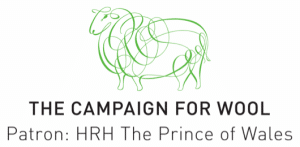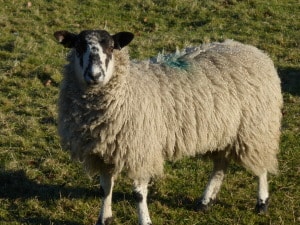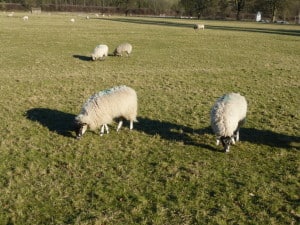 Wool is one of the oldest and most universal fibres and has been used for garments and household linens since the earliest civilizations. Wool textiles have been documented as far back as 3000 B.C. The sheared fleece of sheep, wool is warm, naturally insulating, water-repellent, and extremely durable. Raised in nearly every country worldwide, merino sheep are renowned for the best quality wool. Today, Australia produces about 80% of the world’s merino wool.
Wool is one of the oldest and most universal fibres and has been used for garments and household linens since the earliest civilizations. Wool textiles have been documented as far back as 3000 B.C. The sheared fleece of sheep, wool is warm, naturally insulating, water-repellent, and extremely durable. Raised in nearly every country worldwide, merino sheep are renowned for the best quality wool. Today, Australia produces about 80% of the world’s merino wool.
What is Merino Wool?
Merino wool is made of the finest grades of wool from the Merino sheep. It is prized for being very soft and comfortable against the skin. Modern technology has made it possible to sort and select only the finest merino fibres. Merino wool has a microscopic diameter – about one-third to one-tenth the thickness of human hair. The smaller the diameter, the finer, softer and less scratchy the fabric will be.
Lustrous merino wool produces fabric that can be worn next to the skin without discomfort, is soft and always provides an exceptional hand and distinctive style. In the dress-goods and knitting trades, the term ‘Merino’ implies an article made from the very best soft wool. Extrafine Merino is a super premium wool used in the highest quality knits.
The Varieties of Merino Sheep
 Since the first merino sheep arrived in Australia at the end of the 19th century, sheep farmers have been working to perfect the very creatures that grow such a valuable fibre on their bodies. There are many sub-species of the sheep that provide the merino wool that is so well loved:
Since the first merino sheep arrived in Australia at the end of the 19th century, sheep farmers have been working to perfect the very creatures that grow such a valuable fibre on their bodies. There are many sub-species of the sheep that provide the merino wool that is so well loved:
1. Poll Merino – this is a comparatively new addition to the breed of merino sheep. It is bred for the ease of handling and lack of horns on the rams.
2. The Fonthill Merino – this breed of sheep was created by crossing an American bred merino with a Saxon strain that is known for its fine wool.
3. The Boorla Merino – this strain of merino sheep has a long breeding season and is extremely fertile.
Grades of Merino Wool
The finest garments and products are made with the highest grades of merino wool. Merino sheep produce wool that is less than 24 microns in diameter. The finer it gets, the softer and more expensive the merino wool.
<17.5 microns – Ultrafine merino
17.6-18.5 microns – Superfine merino
<19.5 microns- Fine merino (also interchangeably called Extra Fine merino)
19.6-20.5 microns – Fine medium merino
20.6-22.5 microns – Medium merino
22.6-<24 microns – Strong merino
Characteristic’s of Merino Wool
 Thousands of years of evolution and selective breeding have resulted in merino sheep capable of producing a super-fine wool fibre. Merino wool products of the fine and superfine grades of wool are much finer and superior than traditional wool, making it smooth against the skin and more comfortable to wear. With many more fibres contained in the fabric, it traps more tiny air pockets and locks in body heat, making it a super insulator.
Thousands of years of evolution and selective breeding have resulted in merino sheep capable of producing a super-fine wool fibre. Merino wool products of the fine and superfine grades of wool are much finer and superior than traditional wool, making it smooth against the skin and more comfortable to wear. With many more fibres contained in the fabric, it traps more tiny air pockets and locks in body heat, making it a super insulator.
Merino wool is highly breathable because the individual fibres can absorb up to 30% of their own weight in moisture, wicking moisture away from the body so the wearer stays dry and comfortable regardless of the temperature. This helps to regulate the body temperature, keeping you warm in cold weather and cool in hot.
Merino wool warms naturally. The unique qualities of soft merino wool make it the best material for children’s undergarments. A moving and sweat-prone child will feel comfortable in merino wool the wool breathes freely and will not feel cold and sweaty even when damp. Thanks to its warmth, merino wool is also perfect for a child playing quietly. Merino wool, being the softest of all wool types, is often also suitable for allergic skin as it generally does not cause allergic reactions.
The extremely fine, soft and crimped nature of merino wool fibres allow for a strong natural elasticity that enhances its high-performance qualities. The natural anti-microbial properties of Merino wool make it odor-resistant – another big advantage over synthetic fabrics. It is also extremely durable, anti-static and fire resistant, making it ideal for a range fo products from performance wear to fine wool suiting.
Why Merino?
Don’t synthetics do the job just as well?
Scientific tests carried out by the Hohenstein Institute in Germany, the Ergonomics Unit at the Polytechnic Institute of Wales, and the CSIRO in Australia support anecdotal evidence that Superfine Merino provides the wearer with superior overall climate control and moisture absorption than synthetics. Studies have also confirmed that merino offers higher natural UV protection than many other fibres including cotton.
Well-known for its warmth, it is less well known that the same properties makes Merino the idea fabric for hot weather. The Bedouin tribes of the Sinai, where temperatures reach extreme highs, have been wrapping themselves in wool for centuries. The merino works as a condition buffer; in the heat cooling the body initially through managing the build up moisture vapor internally, keeping the wearer drier for longer. Then, by not clinging to the skin even when wet, the fabric allows the skin to still do it’s job through sweating and cooling the body.
What about new natural fibres like bamboo, hemp and cellulose-based fabrics?
Whilst these fibres may be good in hot weather, none of them are capable of managing moisture in the way merino does, nor will they regulate your body temperature, keeping you warm when it’s cold, cool when it’s hot; They would not keep you warm once they get wet. Also, the nature of these fabrics is not “elastic”, so a close-fitting base-layer in these fabrics will not move with your body, restricting movement. Finally, their manufacturing processes are more complex than that for merino, resulting in the use of more energy.
